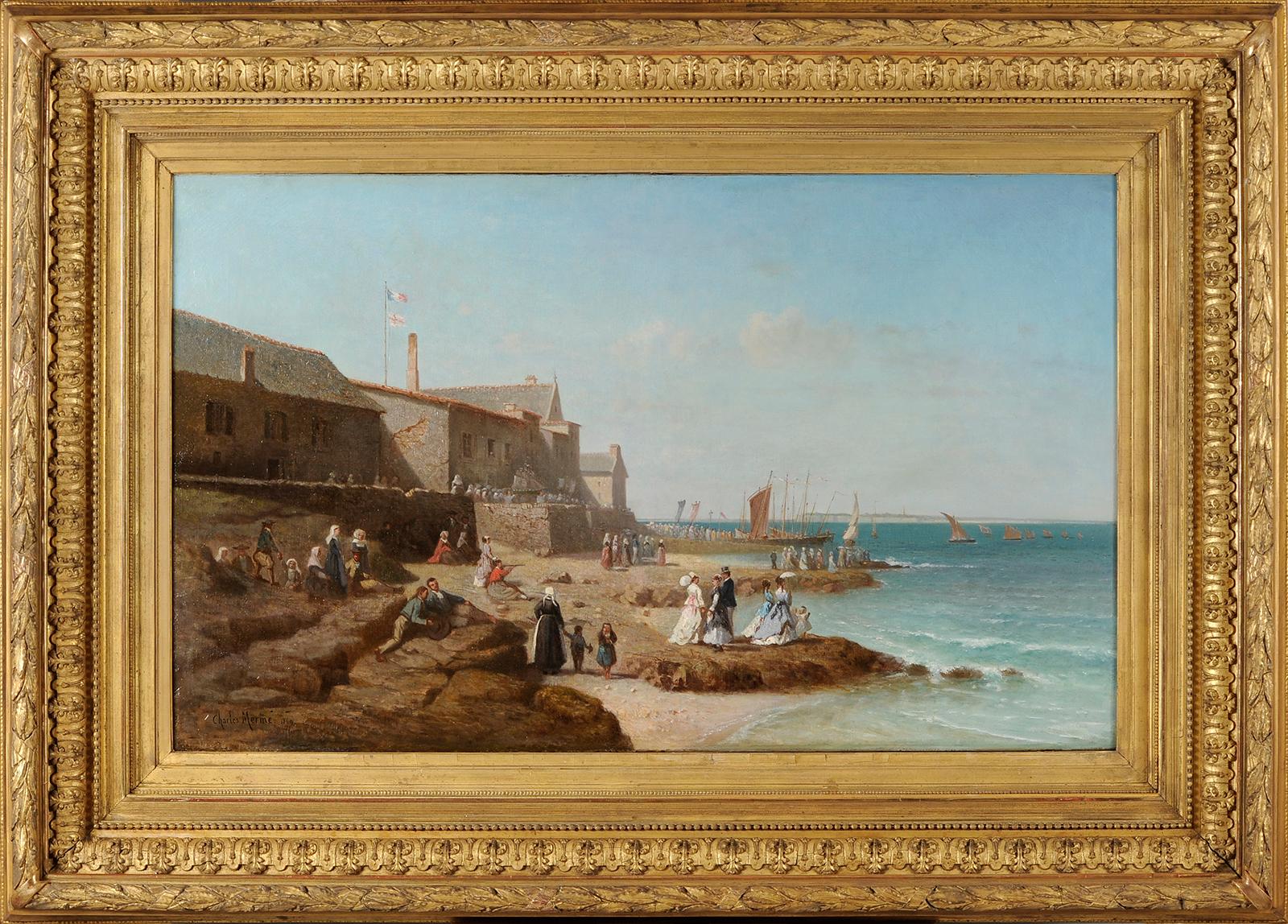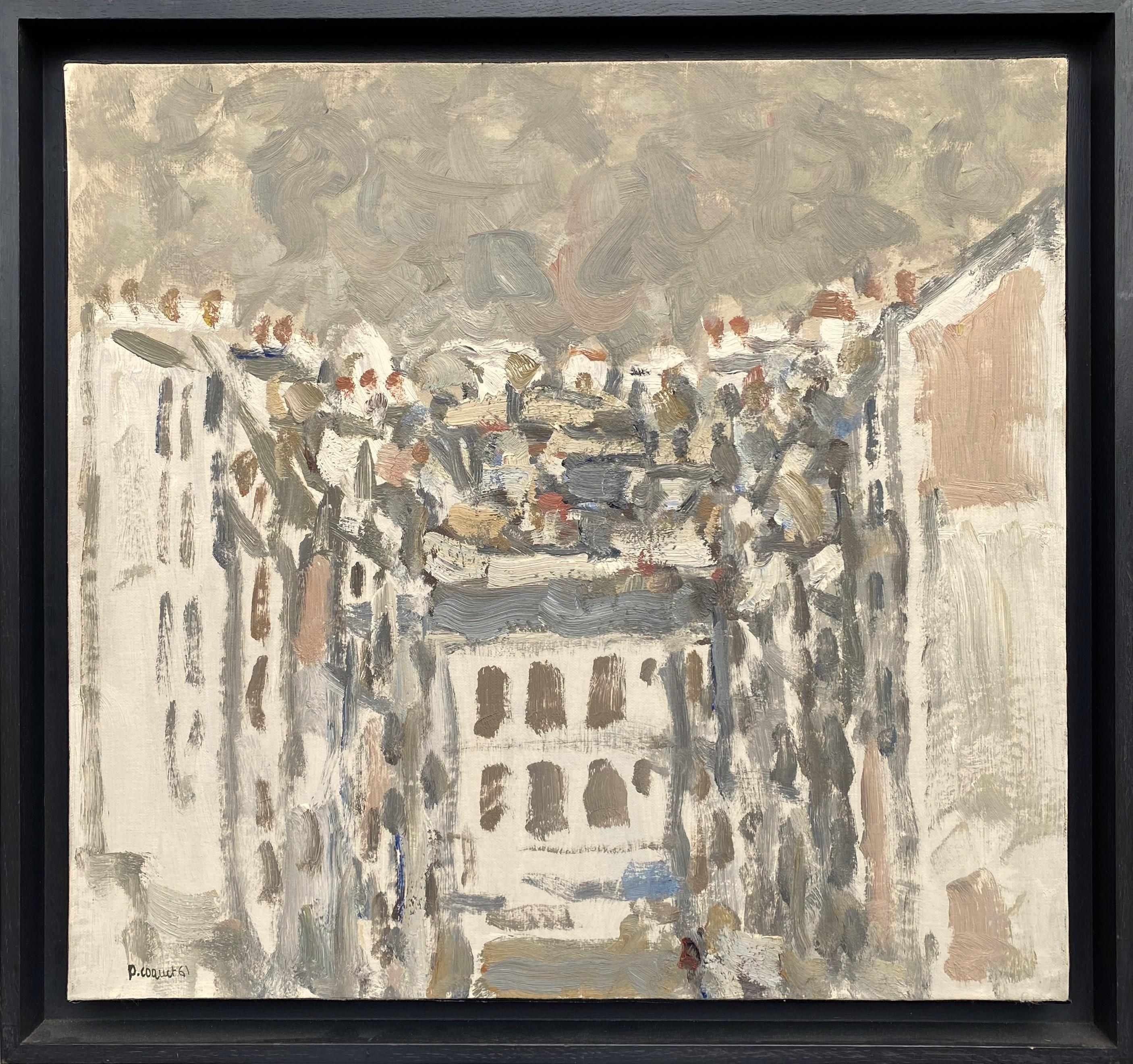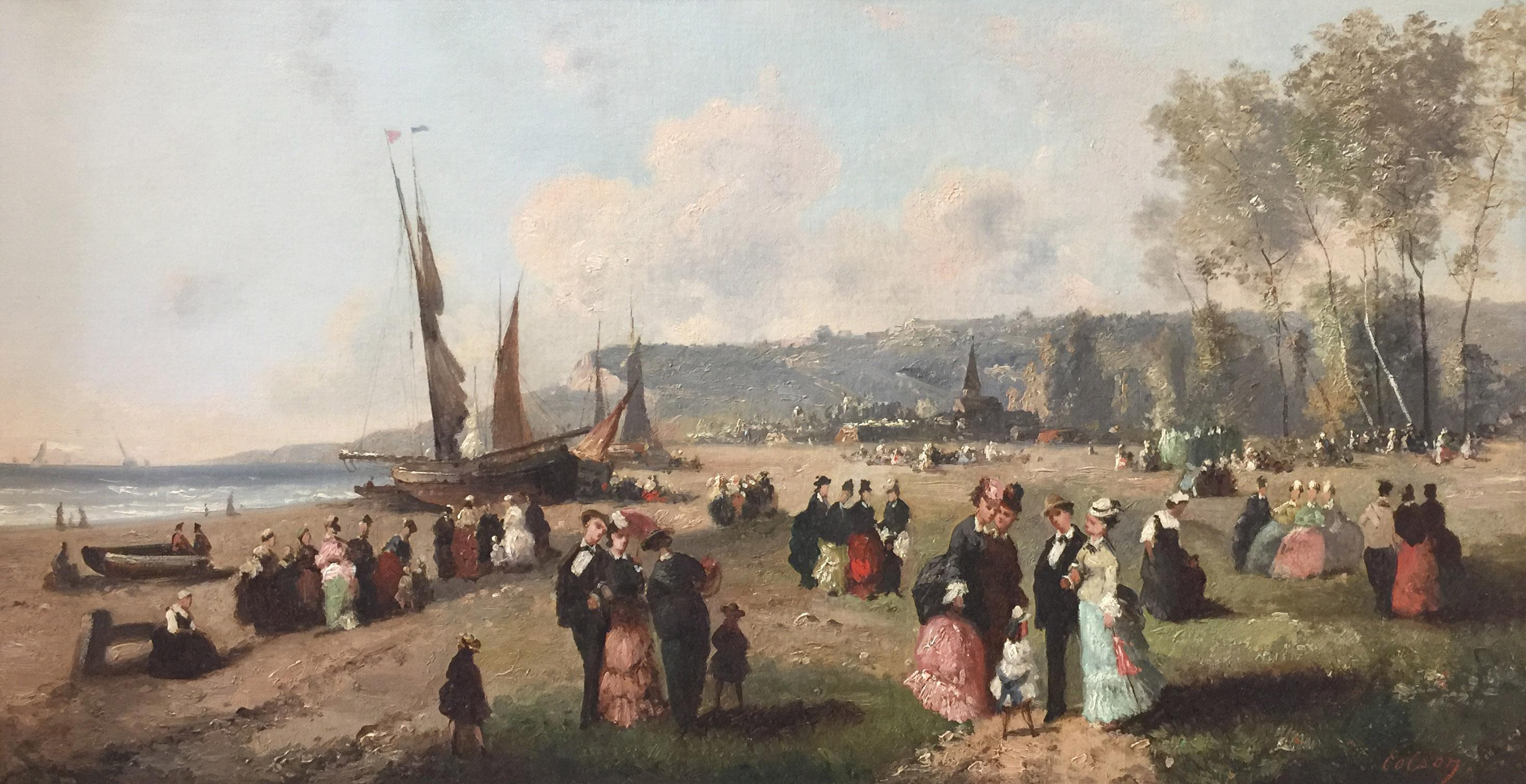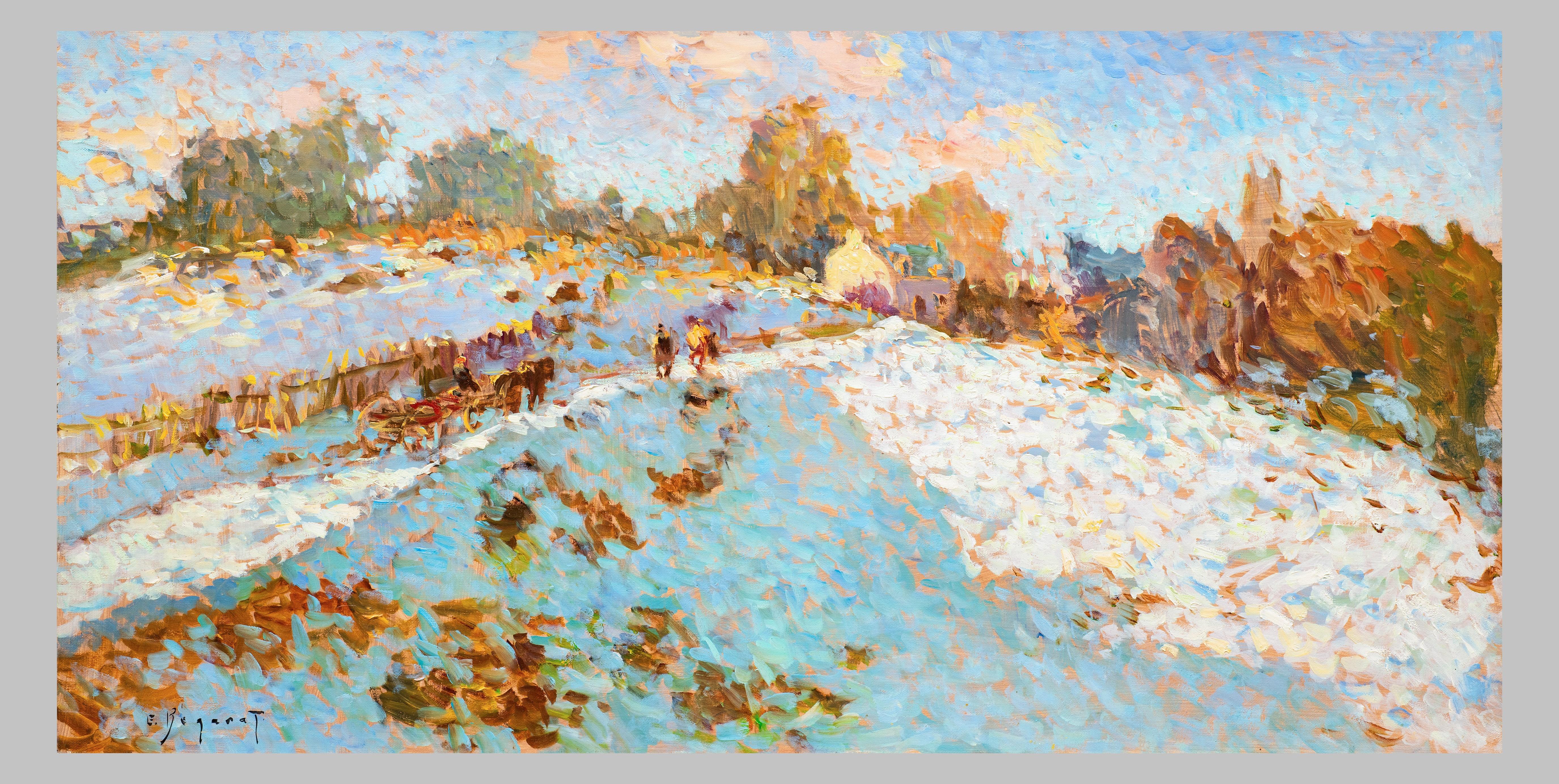Items Similar to François-Edme Ricois (1795-1881) View of Châteaudun castle and city in France
Want more images or videos?
Request additional images or videos from the seller
1 of 10
François-Edmé RicoisFrançois-Edme Ricois (1795-1881) View of Châteaudun castle and city in France1860
1860
About the Item
François-Edme RICOIS
(Courtalain, 1795 - Mareil-Marly, 1881)
View of Châteaudun
Oil on canvas
H. 65 cm; W. 98 cm
Signed and dated lower center 1860
François-Edme Ricois although born in Courtalain in Eure et Loir, spent all his childhood in Châteaudun where his parents ran a rouennerie business. Following very basic studies at the elementary school in the city, his family placed him around thirteen in a notarial office. The experience is not happy: while copying his roles, the young clerk decides to illustrate them with flowers, animals and figures. The lawyer considers that the drawing on stamped paper cost him a little dear and with great regret, he returned the young Ricois to his parents. Fortunately, they had known the Duke of Montmorency, lord of Courtalain for a long time, who took an interest in the young man and directed him to the studio of a renowned artist of his acquaintances, the painter Gros. But the budding artist was more drawn to the landscape than to history painting; also on March 2, 1816, he entered the École des Beaux-Arts and became a pupil of Girodet, Charles Bourgeois and above all Jean-Victor Bertin, himself master of Corot, from whom he was nourished by the principles of neo -classicism, and applied them throughout his life with intelligent flexibility in his views of town, port and castle which remain precise and poetic testimonies of the French province in the last century. To the advice of his masters, Ricois added personal outdoor work, traveling all over France and even Switzerland. He began at the Salon in 1819 and participated in it throughout his life, his last shipment dating from 1880, a few months before his death. He was awarded a second class medal in 1824. This success put him in vogue and from then on, he never ceased to take part in Parisian salons and various provincial exhibitions, notably in Douai, Lille, Toulouse and Cambrai, where he was still a medalist. He would undoubtedly have known the highest honors of his career, if a cruel mourning, the death of his young wife, Marie Constance Denin, which occurred after four years of marriage, had not turned his life upside down. Having become neurasthenic, he settled in Nantes, founded a mixed workshop there, and trained many students for many years. But the demon of his freedom quickly took him back, and from 1834 he devoted himself to the study of the castles of the Loire. Not ceasing to travel to the four corners of France, the painter left a considerable documentary work of which it would be difficult to establish the catalog; locally, he reproduced the main châteaux of Eure-et-Loir: Châteaudun, Courtalain, Maintenon, Montigny-le-Gannelon, with a predilection for sites in the south of the department. His technique is diverse: the landscapes are treated with oil, watercolor, wash, and he will also devote himself to fixed on glass, a process in vogue in the 19th century. It was in Mareil-Marly, near Saint-Germain-en-Laye where he had acquired a property, that Ricois spent the last part of his life. The surroundings of Saint-Germain provided him with material for a very large number of paintings. But to repeat himself, the artist soon lost his originality and his charm ... Having reached an advanced age, at 77, he nevertheless still obtained bronze medals at the international exhibition in London in 1875. This was the last burst of its flame. He lived a few more years, but his weakened eyesight forced him to give up the last sketches he was still making. From his union was born a daughter on December 2, 1830 named Marie-Octavie Ricois who was herself a painter and drawing teacher.
Source: - C. Léger: "Artistes dunois (XIXè - XXè centuries)", year 2005, pp 4/5
About the castle of Châteaudun: Of a spectacular scale, the castle of Châteaudun saw its construction spread over four centuries . From the end of the 12th century, Thibaud V, Count of Blois, built the keep still visible today and the last vestige of the medieval castle. Two centuries later, the Château de Châteaudun became the property of Jean d'Orléans, Joan of Arc's favorite companion. Between 1450 and 1468, he had the Dunois wing built, a two-storey main building whose layout reflects the need for comfort that followed the Hundred Years War. He also built a Gothic Holy Chapel adjoining the keep, designed to keep the relics of Christ. Construction work was completed in the 16th century with the construction of a second wing facing the Loir, the so-called “Longueville” wing, named after the family who had it built. The profound originality of the Château de Châteaudun comes from the fact that the Middle Ages gradually disappeared there in favor of the Renaissance while making the two styles perfectly coexist.
- Creator:François-Edmé Ricois (1795 - 1881, French)
- Creation Year:1860
- Dimensions:Height: 25.6 in (65 cm)Width: 38.59 in (98 cm)
- Medium:
- Movement & Style:
- Period:
- Condition:Perfect condition. Cleaned.
- Gallery Location:BELEYMAS, FR
- Reference Number:1stDibs: LU1860210072752
About the Seller
No Reviews Yet
Vetted Seller
These experienced sellers undergo a comprehensive evaluation by our team of in-house experts.
Established in 2011
1stDibs seller since 2022
- ShippingRetrieving quote...Ships From: BELEYMAS, France
- Return PolicyThis item cannot be returned.
More From This SellerView All
- Charles Merme (1818-1869) The blessing of Coureau de Groix in Larmor BrittanyLocated in BELEYMAS, FRCharles MERMÉ (Cherbourg 1818 - Lorient 1869) The blessing of Coureau de Groix at Larmor Oil on canvas H. 60 cm; W. 100 cm Signed and dated lower left, 1...Category
1860s French School Figurative Paintings
MaterialsCanvas, Oil
- View taken in the Park of Saint-Cloud near ParisLocated in BELEYMAS, FRAlexandre-Hyacinthe DUNOUY (Paris, 1757 – Jouy en Josas, 1841) View taken in the park of Saint-Cloud Oil on paper mounted on canvas H. 31.5 cm; L. 24 cm Around 1820 Provenance: -Per...Category
1810s French School Figurative Paintings
MaterialsCanvas, Oil
- Maurice Lobre (1862 -1951) The snackBy Maurice LobreLocated in BELEYMAS, FRMaurice LOBRE (Bordeaux 1862 - Paris 1951) Le goûter Huile sur toile H. 87 cm ; L. 91,5 cm Format peint d’origine, H. 101 cm ; L. 96 cm, disposé sur un châssis plus petit par l’artiste lui-même. Signée et datée 1888 en bas à droite Provenance : Collection privée, Lyon Exposition : 1889, Salon des Artistes Français, n°1719 « Intérieur », (ou 1720 nommé également « Intérieur ») Œuvres en rapport : Le Cabinet de toilette de Jacques-Emile Blanche, (titre erroné) H. 80 cm ; L. 85 cm, HST, Museo Thyssen-Bornemisza, Madrid, pendant de notre toile. Maurice Lobre a-t-il connu Marcel Proust ? On ne peut encore l'affirmer, bien qu'il ait eu de nombreux amis en commun avec l'écrivain. Mais sa peinture intimiste pourrait illustrer certaines pages de Du côté de chez Swann. Trois citations dues à des proches de Proust, l'une de l'écrivain Léon Daudet, la seconde du peintre Jacques-Emile Blanche, la dernière du poète mondain Robert de Montesquiou, donnent un aperçu de ce que fut la renommée de Maurice Lobre en son temps : "Il en va autrement de Lobre, le Vermeer français, le peintre exquis des intérieurs et des palais de Versailles, des reflets sur les meubles rares, de la lumière prisonnière des miroirs, des laques et des cuivres polis. Lobre est joyeux comme un coup de vent, qui fait envoler les préjugés et les poncifs, éloquent, passionné, ivre de la couleur et des formes, charmant et conquérant de toutes les matières. Il se promène ici-bas ainsi que dans un musée en plein-air, s'amuse de tout, rejette et maudit le laid et le vil, accueille et bénit le beau et le bien…" Léon Daudet L'Entre-deux-guerres. Souvenirs des milieux littéraires, politiques, artistiques et médicaux de 1880 à 1905. "Voici le patient, appliqué, sage M. Lobre. Il est difficile de mettre plus d'honnêteté à peindre des intérieurs sans figures. Je préfère ses petits salons de Versailles à ses cathédrales… Nous lui devons des petits bijoux d'émotion et de large fini." Jacques-Emile Blanche "Il a recueilli sur des toiles le visage du vieux Versailles (…). Il a peuplé de visions impalpables des chambres " où il s'est passé quelque chose ", et il en a saturé l'atmosphère de particules historiques. Donner une telle impression avec certitude, avec vérité, c'est plus difficile que de faire évoluer des personnages costumés, dans ce qu'on appelle bêtement "une reconstitution historique"." Comte Robert de Montesquiou Maurice Lobre commence sa carrière au Salon de 1882 où il expose deux portraits, dont celui de son camarade de l'atelier Carolus-Duran, le peintre espagnol Ramon Casas...Category
1880s French School Figurative Paintings
MaterialsCanvas, Oil
- Roof of ParisLocated in BELEYMAS, FRHenri Ernest Clément DUPONT-CRESPIN (Notre Dame de Bondeville 1882 – Paris 1953) View of the rooftops of Paris Oil on canvas H. 65 cm; L. 92 cm Signed and dated lower right “3-1948” Exhibition: 60th exhibition of the Salon des Indépendants from April 22 to May 15, 1949 at the Musée des Beaux-Arts de la ville de Paris under number 893 Henri Dupont was born in Normandy near Rouen, and to stand out from his very, even too classic, name, he adopted that of his mother as a complement, which would become his unique artist name. He was a drawing teacher at the Épinal high school and also worked at the town museum, lending his eye to the identification of several old paintings. From 1928 and until the day before his death, Dupont-Crespin exhibited at the Salon des Indépendants. The vast majority of his works are landscapes, but there are also portraits of his colleagues, friends and relatives. In 1940 he published a collection of engravings...Category
1940s French School Figurative Paintings
MaterialsOil, Canvas
- Landscape of Ile de FranceBy Jean-Victor BertinLocated in BELEYMAS, FRJean-Victor BERTIN and workshop (1767, Paris – 1842, Paris) Landscape of Ile de France Oil on canvas H. 38 cm; L. 46 cm Related work: painting of the same composition preserved at t...Category
Early 1800s French School Figurative Paintings
MaterialsOil, Canvas
- Henri Pailler - Snow in Triel sur SeineBy Henri PaillerLocated in BELEYMAS, FRHenri PAILLER (Poitiers 1876 - Triel-sur-Seine 1954) Snow in Triel sur Seine Oil on canvas H. 54 cm; L. 73 cm Signed lower left Provenance: Private collection, Vienne A native of Poitiers in Vienne, Henri Pailler shows serious drawing skills. Noticed by Edmond Petitjean, the young man was sent to Paris to complete his training at the Beaux-Arts under the aegis of the great Léon Bonnat. First of all accustomed to a style and a very academic palette, the young painter quickly branched off from this classical art which he hardly liked. From the beginning of the century he moved towards Impressionism which he deployed within the Crozant school thanks to his meeting with Armand Guillaumin who took him to paint on the motif in 1901. Residing in Poitiers until the At the dawn of the great conflict of 1914, Pailler sent to the Salon many landscapes of the Creuse where the liveliness of colors was more and more felt. It is precisely following the meeting with Dufy and Marquet that a fawn side appears in his compositions, but after a few years he instinctively returns to his love for impressionism by keeping a generous amount of hues on his palette. On his return from the war, Henri Pailler joined Roubaix where he was appointed workshop professor at the School of Industrial Arts. On his retirement he will settle on the banks of the Seine in Triel-sur-Seine, of which he will realize many views with the talent and the colors so appreciated by this painter considered to be one of the greats of Crozant. Throughout his career, Pailler will travel through France and regularly in Périgord, from which he will bring back many works by Bourdeilles mainly but also Brantôme. From the 1920s, the painter will present views of Triel-sur-Seine in the Yvelines in various salons. This town, whose church with its distinctive silhouette will be the playground for Pailler's easel until his death. Our painting undoubtedly made in the 1920s is a striking winter image...Category
1920s French School Figurative Paintings
MaterialsOil, Canvas
You May Also Like
- View of Paris, oil painting by Pierre CoquetLocated in Montfort l’Amaury, FRReference number F367 The painting is framed with a dark grey wood floated frame. 50 x 53 cm frame included (45 x 48 cm without frame) This work is painted with oil on a canvas. It i...Category
1960s French School Figurative Paintings
MaterialsCanvas, Oil
- Guillaume-François Colson - Sur la plage, french, beach, 19th century, paintingLocated in London, GBGuillaume-François Colson (1785-1860) Sur la plage oil on canvas 35 x 65 cm signed 'Colson' (lower right) Price: £18,000 GBP Provenance: MacConnal-Mason Fine Paintings Private coll...Category
19th Century French School Landscape Paintings
MaterialsCanvas, Oil
- Pointillist Painting "The Road Beneath the Snow" Eugène Bégarat (French, 1943)By Eugène BégaratLocated in SANTA FE, NMPointillist Painting "The Road Beneath the Snow (Le Chemin Sous la Neige)" Eugène Bégarat (French, 1943) Oil on canvas 15 3/4 x 31 1/2 inches Saturated with winter's light glinting...Category
20th Century French School Landscape Paintings
MaterialsOil, Canvas
- A Soldier Blowing the Trumpet by French Artist Charles Bouchez, Oil on CanvasLocated in Stockholm, SECharles Bouchez (1811-1882) French A Soldier Blowing the Trumpet oil on canvas signed and dated ch. Bouchez 1842 canvas dimensions 6.29 x 4.13 inches (16 x 10.5 cm) frame 10.23 x 7...Category
1840s French School Figurative Paintings
MaterialsCanvas, Oil
- In the Garden, French school impressionist, original oil on canvas, figurativeLocated in Nutfield, SurreyAn early 20th Century French School oil on canvas painting of a lady and her dog in a garden in summertime. This high-quality warm and vibrant, although unsigned, work is deftly pain...Category
Early 20th Century French School Figurative Paintings
MaterialsCanvas, Oil
- Boy in a landscape, large art deco period paintingLocated in Norwich, GBThis luminous landscape is perfectly capturing the light of early spring. A boy is climbing over wooden farm gates, with a backdrop of rolling hills. The painting has a gloriously fr...Category
1930s French School Landscape Paintings
MaterialsCanvas, Oil
Recently Viewed
View AllMore Ways To Browse
Antique In French
Antique In France
French City Painting
City View Painting
Union City
French Castle
Castle Style
French Renaissance Painting
Lost City Of Arts
French Art Provincial
Corner Built In
Art Of Toulouse France
Union Of London
French Marriage
Francois Oil Painting
French Germain
1881 Oil Paintings
Antique Castle Painting





